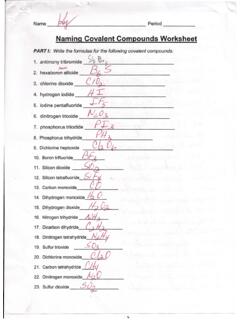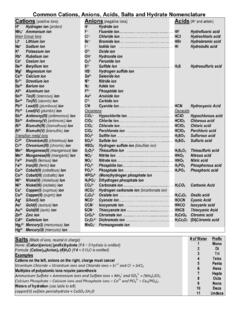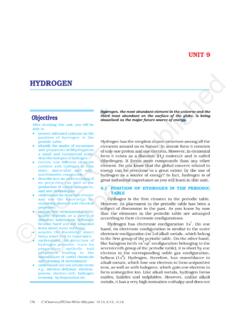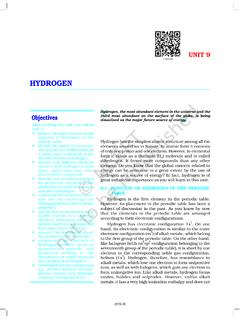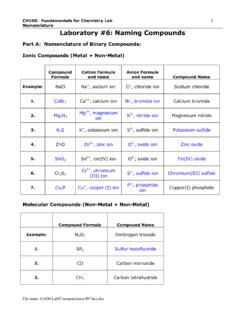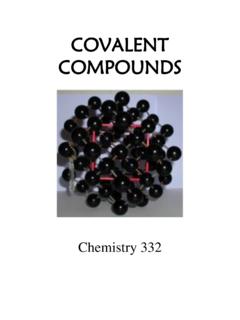Transcription of Common Polyatomic Ions - West Virginia University
1 115 PLTL Activity Sheet # 4 1 Naming Ionic & Covalent Compounds General Information: Common Polyatomic Ions +1 Charge NH4+ ammonium H3O+ hydronium Hg22+ mercury(I) 1 Charge AlO2 aluminate BrO hypobromite BrO2 bromite BrO3 bromate BrO4- perbromate CH3 COO acetate HCO3 hydrogen carbonate ClO hypochlorite ClO2 chlorite ClO3 chlorate ClO4 perchlorate CN cyanide CNO cyanate CNS thiocyanate CrO2 chromite HSO3 hydrogen sulfite HSO4 hydrogen sulfate IO - hypoiodite IO2 - iodite IO3 iodate IO4 periodate MnO4 permanganate NO2 nitrite NO3 nitrate N3 azide OH hydroxide
2 O2 superoxide H2PO3 - dihydrogen phosphite H2PO4 dihydrogen phosphate 2 Charge HPO32 hydrogen phosphite HPO42 hydrogen phosphate CO32 carbonate SO32 sulfite SO42 sulfate S2O32 thiosulfate SiO32 silicate C22 carbide C2O42 oxalate CrO42 chromate Cr2O72 dichromate C4H4O62 tartrate MoO42- molybdate O22 peroxide S22 disulfide 3 Charge PO33 phosphite PO43 phosphate PO23 hypophosphite AsO33 arsenite AsO43 arsenate 4 Charge P2O74 pyrophosphate **Most commonly encountered ions in bold.
3 Polyatomic Ions - A group of atoms held together by covalent bonds found in ionic compounds. Know/ memorize/ recognize names, formulas and charges! 115 PLTL Activity Sheet # 4 2 General Information: Recognizing Ionic vs. Covalent Compounds: Ionic: Metal plus non-metal or Metal plus Polyatomic ion or Polyatomic ion plus Polyatomic ion Molecular/ Covalent: Contains only non-metal atoms Chemical Formula - Indicates the number and type of atoms in the base unit of a compound.
4 Type of compound Base unit Ionic Formula unit ( ) Molecular Molecule Valence Electrons - Electrons in the outermost shell of an atom The only e s involved in bonding and chemical reactions. For the S- & P-blocks: # Valence e = Group number Ionic Compounds: An electrostatic attraction between a positive ion and a negative ion, where one or more electrons have been transferred from the valence shell of one atom to the valence shell of the other atom. Molecular Compounds: Sharing valence electrons between atoms of different elements form COVALENT bonds Octet Rule - An atoms tends to gain, lose or share such that it achieves eight valence electrons.
5 There are some exceptions to the Octet Rule! Formation of Ionic Compounds: All compounds are electrically neutral possess no net charge. Number of positives = number of negatives CompoundsIonic held together thru mutual attraction of oppositely charged ions, opposites attract Covalent/ molecular held together by covalent bonds; shared electron pairsCompoundsIonic held together thru mutual attraction of oppositely charged ions, opposites attract Covalent/ molecular held together by covalent bonds.
6 Shared electron pairs115 PLTL Activity Sheet # 4 3 Cations Monatomic Only one ion possible More than one ion possible Rule: Name of element + ion Examples: Na+ sodium ion Mg2+ magnesium ion H+ hydrogen ion Sr2+ strontium ion Al3+ aluminum ion Comment: The number of positive charges is not indicated in the name because it is not necessary Rule: (a) Newer rule: positive charges indicated by Roman numeral. Examples: Fe2+ iron(II) ion Fe3+ iron(III) ion Cu+ copper(I) ion Cu2+ copper(II) ion (b) Older but still used rule: Latin stem for the element + ous for the lesser charge and ic for the greater charge.
7 Examples: Fe2+ ferrous ion Fe3+ ferric ion Cu+ cuprous ion Cu2+ cupric ion Sn2+ stannous ion Sn4+ stannic ion Polyatomic Rule: ??? Examples: NH4+ ammonium ion H3O+ hydronium ion Hg22+ mercurous ion or mercury(I) ion Nomenclature Flow charts 115 PLTL Activity Sheet # 4 4 Anions Anions Rules: Stem of the element + ide Examples: H- hydride ion F- fluoride ion O2- oxide ion N3- nitride ion C4- carbide ion Oxy-anions Rules: least oxygen: hypo__ite ion less oxygen: __ite ion more oxygen: __ate ion most oxygen: per__ate ion Examples.
8 ClO- hypochlorite ion ClO2- chlorite ion ClO3- chlorate ion ClO4- perchlorate ion SO32- sulfite ion SO42- sulfate ion NO2- nitrite ion NO3- nitrate ion Comment: Halogens (except F) form all four ions. When only two of the four ions exist, they are ite and ate ions. Others and Exceptions Rules: These items do not follow any rules; they must be memorized Examples: OH- hydroxide ion CN- cyanide ion SCN- thiocyanide ion OCN- cyanate ion O22- peroxide ion O2- superoxide ion MnO4- permanganate ion C2H3O2- acetate ion Cr2O72- dichromate ion C2O42- oxalate ion Oxy-anions containing Hydrogen Rules: H- oxy-anion: hydrogen + name of oxy-anion or bi + name of oxy-anion.
9 H2- oxy-anion: dihydrogen + name of oxy-anion Examples: HCO3- hydrogen carbonate ion or bicarbonate ion HSO4- hydrogen sulphate ion HPO42- Hydrogen phosphate ion or biphosphate ion H2PO4- dihydrogen phosphate ion Comment: H2CO3 is not named according to this rule because it is a compound and not an ion. 115 PLTL Activity Sheet # 4 5 Compounds Molecular Ionic Rule: Name of the cation + name of anion (word ion dropped) Examples: NaCl sodium chloride MgCl2 magnesium chloride Fe3N2 iron(II) nitride Na2CO3 sodium carbonate NH4OH ammonium hydroxide CaH2 calcium hydride Comment: The name does not indicate the numbers of cations and anions because there is only one possibility for the ions to combine and form a compound.
10 Rule: a. Less electronegative atom first (exceptions: when one of the elements is hydrogen.) b. Number of each kind is specified by Greek prefixes. c. prefix mono at beginning is dropped. Prefixes: 1=mono 6=hexa 2=di 7=hepta 3=tri 8=octa 4=tetra 9=nona 5=penta 10=deca Examples: N2O4 dinitrogen tetraoxide CO carbon monoxide CO2 carbon dioxide NO2 nitrogen dioxide N2O dinitrogen monoxide Note: several trivial names H2O water H2O2 hydrogen peroxide NH3 ammonia 115 PLTL Activity Sheet # 4 6 Rule 1: w/o presence of H2O: hydrogen __ide Examples: HCl hydrogen chloride HF hydrogen fluoride H2S hydrogen sulfide Rule 2: when dissolved in H2O.
